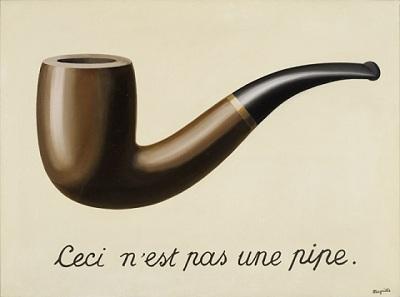Last Friday, René Magritte’s iconic masterpiece, The Treachery of Images (This is Not a Pipe) (La trahison des images [Ceci n’est pas une pipe]) (1929), left its home in LACMA’s Modern Art wing for New York. The painting will be featured in the yearlong exhibition, Magritte: The Mystery of the Ordinary, 1926–1938, opening later this month at the Museum of Modern Art, New York, before traveling to the Menil Collection, Houston, and the Art Institute of Chicago.
![René Magritte, The Treachery of Images (This Is Not a Pipe) (La Trahison des images [Ceci n'est pas une pipe]), 1929, purchased with funds provided by the Mr. and Mrs. William Preston Harrison Collection, © 2013 C. Herscovici, London / Artists Rights Society (ARS), New York](/sites/default/files/attachments/ma-31824080-web.jpg) René Magritte, The Treachery of Images (This Is Not a Pipe) (La Trahison des images [Ceci n'est pas une pipe]), 1929, purchased with funds provided by the Mr. and Mrs. William Preston Harrison Collection, © 2013 C. Herscovici, London / Artists Rights Society (ARS), New York
René Magritte, The Treachery of Images (This Is Not a Pipe) (La Trahison des images [Ceci n'est pas une pipe]), 1929, purchased with funds provided by the Mr. and Mrs. William Preston Harrison Collection, © 2013 C. Herscovici, London / Artists Rights Society (ARS), New York
Magritte (1898–1967)—a Belgian artist most often associated with the Surrealist movements in Paris and Brussels—created a body of work that explored perceptions of reality and illusion and the disjunction between images and language. The Treachery of Images (This is Not a Pipe) exemplifies his masterful word-image paintings by pairing a picture of a pipe with the contradictory phrase, “Ceci n’est pas une pipe” (This is Not a Pipe). Though Magritte’s pipe certainly looks like one, the artist’s linguistic rejection asserts that the painted representation is not synonymous with the real thing.
![Installation at LACMA of René Magritte, The Treachery of Images (This Is Not a Pipe) (La Trahison des images [Ceci n'est pas une pipe]), 1929, purchased with funds provided by the Mr. and Mrs. William Preston Harrison Collection, © 2013 C. Herscovici, London / Artists Rights Society (ARS), New York (left) and René Magritte, The Liberator, 1947, gift of William Copley, © 2013 C. Herscovici, London / Artists Rights Society (ARS), New York (right)](/sites/default/files/attachments/magritte_cest1-e1378747474295.jpg) Installation at LACMA of René Magritte, The Treachery of Images (This Is Not a Pipe) (La Trahison des images [Ceci n'est pas une pipe]), 1929, purchased with funds provided by the Mr. and Mrs. William Preston Harrison Collection, © 2013 C. Herscovici, London / Artists Rights Society (ARS), New York (left) and René Magritte, The Liberator, 1947, gift of William Copley, © 2013 C. Herscovici, London / Artists Rights Society (ARS), New York (right)
Installation at LACMA of René Magritte, The Treachery of Images (This Is Not a Pipe) (La Trahison des images [Ceci n'est pas une pipe]), 1929, purchased with funds provided by the Mr. and Mrs. William Preston Harrison Collection, © 2013 C. Herscovici, London / Artists Rights Society (ARS), New York (left) and René Magritte, The Liberator, 1947, gift of William Copley, © 2013 C. Herscovici, London / Artists Rights Society (ARS), New York (right)
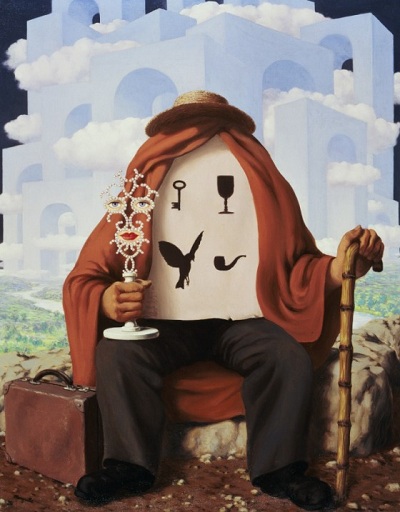 René Magritte, The Liberator, 1947, gift of William Copley, © 2013 C. Herscovici, London / Artists Rights Society (ARS), New York
René Magritte, The Liberator, 1947, gift of William Copley, © 2013 C. Herscovici, London / Artists Rights Society (ARS), New York
The painting entered LACMA’s collection in 1978 and occupies an important place within the museum’s holdings of avant-garde art from Europe. It is situated within the Dada, Surrealism, De Stijl gallery on the second floor of LACMA’s Ahmanson Building (gallery 224) among works by artists such as Arshile Gorky, Fernand Léger, Joan Miró, Pablo Picasso, and Yves Tanguy. It also hangs next to the other Magritte painting owned by LACMA, The Liberator (1947). LACMA is the only museum collection in Los Angeles with holdings of works by Magritte, and, with the temporary absence of The Treachery of Images (This is Not a Pipe), LACMA now has a new painting by the artist hanging in its place, on loan from the Menil Collection.
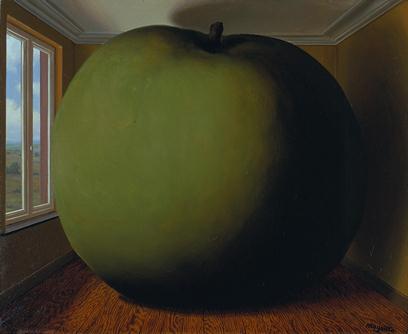 René Magritte, The Listening Room (la chambre d'écoute), 1952, The Menil Collection, Houston. Gift of Philippa Friedrich, © 2013 C. Herscovici, London / Artists Rights Society (ARS), New York
René Magritte, The Listening Room (la chambre d'écoute), 1952, The Menil Collection, Houston. Gift of Philippa Friedrich, © 2013 C. Herscovici, London / Artists Rights Society (ARS), New York
In the spirit of collegiality and scholarship, museums occasionally lend their works to other institutions for exhibitions. This can be difficult to do if the work is greatly loved by the museum’s visitors and its curators, but it can sometimes present an opportunity to exhibit something new from afar. The Menil Collection—which owns a remarkable 54 works by Magritte—has sent their painting, The Listening Room (La chambre d’écoute) (1952), to LACMA for the run of their traveling exhibition, which explores the artist’s earlier work. This painting—from a much later period in Magritte’s career and thus, beyond the scope of their presentation—is emblematic of the artist’s playful compositions of domestic spaces overtaken by dramatically oversized everyday objects, such as apples, roses, drinking glasses, and combs. In The Listening Room, a massive green apple dominates an empty and compact interior with a window revealing the outside landscape. The Belgian poet Paul Colinet, a friend of Magritte, described the artist’s works as “magnetized listening devices” and gave the painting its title.
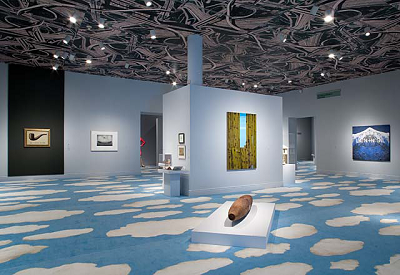 Installation photo of the exhibition Magritte and Contemporary Art: The Treachery of Images (November 2006–March 2007), Los Angeles County Museum of Art, Photo © Museum Associates LACMA
Installation photo of the exhibition Magritte and Contemporary Art: The Treachery of Images (November 2006–March 2007), Los Angeles County Museum of Art, Photo © Museum Associates LACMA
This is not the first time The Listening Room has been on view at LACMA. It was included in the exhibition Magritte and Contemporary Art: The Treachery of Images at LACMA in 2006–7, which examined the artist’s impact on contemporary artists such as John Baldessari (who designed the exhibition), Robert Gober, Ed Ruscha, and others. Magritte’s alterations of scale inspired later artists such as Vija Celmins and Claes Oldenburg, who were both influenced by the iconic larger-than-life-size objects in Magritte’s work. For example, in Untitled (Comb) (1970), currently on view in a gallery adjacent to the Magritte works, Celmins made a sculptural reproduction of a comb in Magritte’s painting, Les valeurs personnelles (Personal Values) (1952).
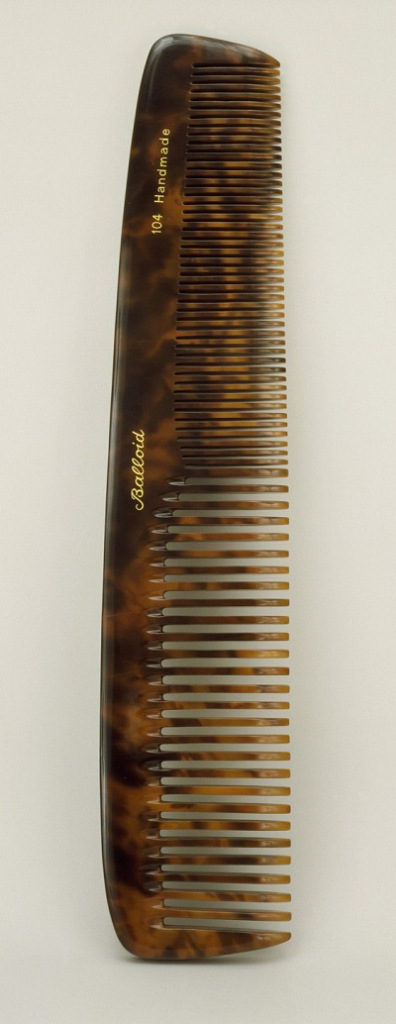 Vija Celmins, Untitled (Comb), 1970, Contemporary Art Council Fund, © Vija Celmins
Vija Celmins, Untitled (Comb), 1970, Contemporary Art Council Fund, © Vija Celmins
The Menil Collection’s The Listening Room is now in an exciting dialogue with LACMA’s The Liberator, a pairing that offers a new perspective on Magritte’s late work. Instead of a large, inflated object that distorts reality, the man in The Liberator sits in a landscape of unfolding structures and clouds with only everyday objects such as a suitcase, cane, and hat to ground him in the real world. Perhaps the fantastical outdoor scene in The Liberator is not far from the one outside The Listening Room’s window? Or perhaps the two paintings demonstrate two unique and independent visions by the artist? The Listening Room and The Liberator will be on view together through October 2014 for you to make your own connections and comparisons.
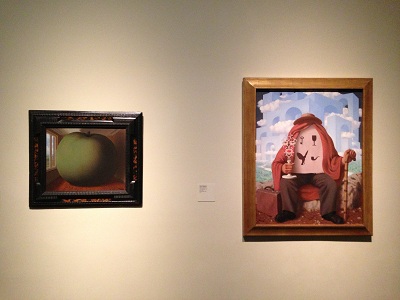 Installation at LACMA of René Magritte, The Listening room (la chambre d'écoute), 1952, The Menil Collection, Houston. Gift of Philippa Friedrich, © 2013 C. Herscovici, London / Artists Rights Society (ARS), New York (left) and René Magritte, The Liberator, 1947, gift of William Copley, © 2013 C. Herscovici, London / Artists Rights Society (ARS), New York (right)
Installation at LACMA of René Magritte, The Listening room (la chambre d'écoute), 1952, The Menil Collection, Houston. Gift of Philippa Friedrich, © 2013 C. Herscovici, London / Artists Rights Society (ARS), New York (left) and René Magritte, The Liberator, 1947, gift of William Copley, © 2013 C. Herscovici, London / Artists Rights Society (ARS), New York (right)
Christine Robinson
Yvonne and Harry Lenart Graduate Intern, Modern Art



